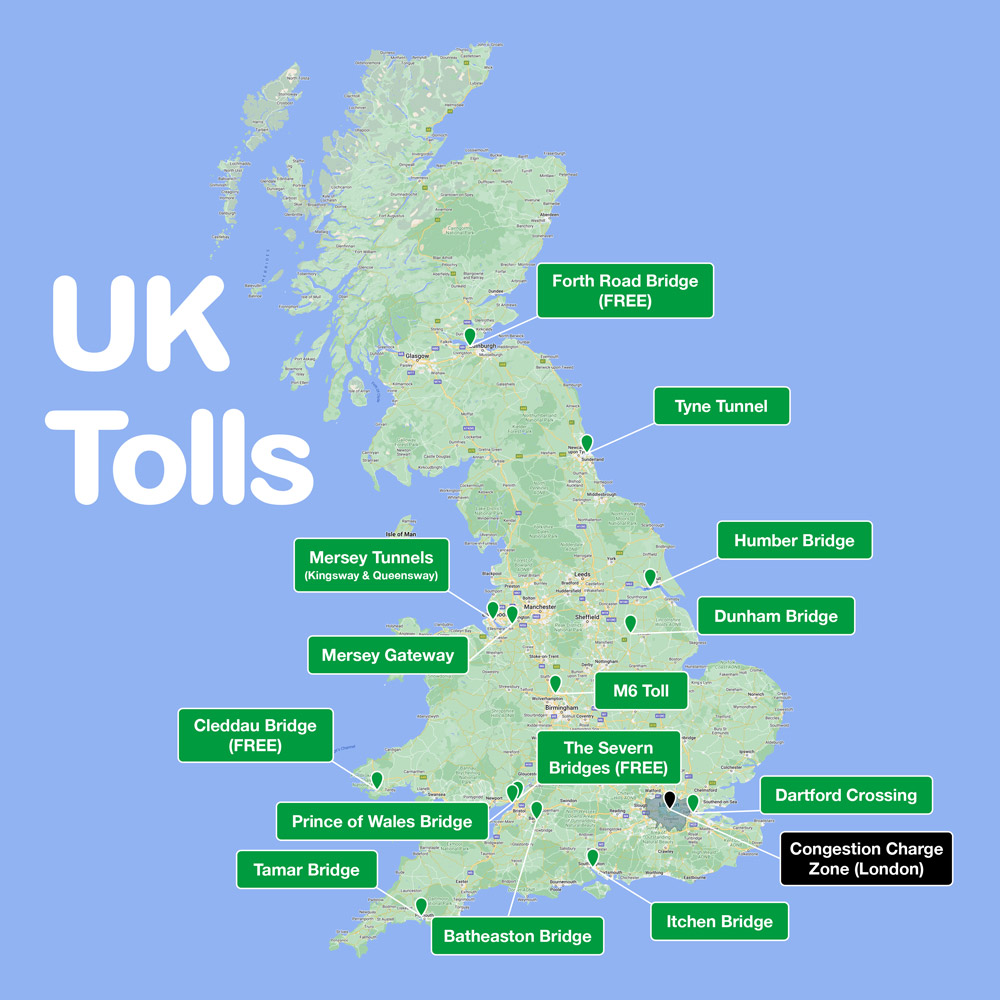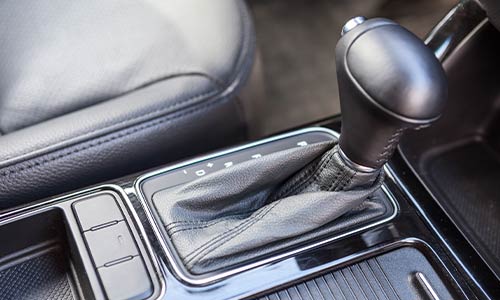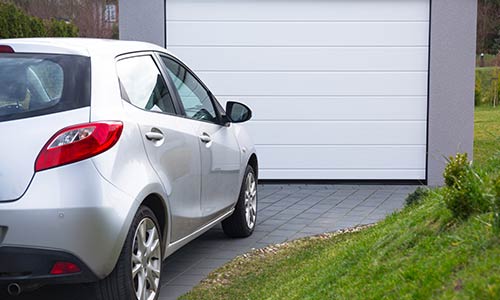A Guide To Tolls In The UK: With Map
Toll roads often provide a direct route to get from one point to another – with the added benefit of avoiding road congestion. However, you’ll usually have to pay a small fee (or toll) for this convenience.
In this comprehensive guide, we will cover what constitutes a toll road, how they operate – and tips and guidance for avoiding toll roads in the UK. We’ve also created a useful map - and a guide to 15 of the UK’s major toll roads (including some routes that are now free to cross) to help you plan your next journey.
Get a free valuation
What is a toll road?
For example, to continue driving along some roads or to cross specific bridges, you may need to pay a toll in cash or by credit/debit card. This toll may be payable immediately – or you might have a short window to make payment online after crossing.
If you cross the threshold of a toll road or bridge (intentionally or not) you will be liable to pay the applicable charge. As such, when planning a journey, it’s important to factor in any toll roads you might encounter along the way.
Taking one or more toll roads along the route is likely to reduce your journey time but will also often increase travel costs.
Why do I have to pay toll charges?
Toll fees are put towards the upkeep and maintenance of toll roads. When using a toll road, you are also paying to take a route that is typically faster and less congested than non-toll alternatives.
Can I pay cash at tolls?
Many toll roads do accept cash, although some (such as the Dartford Crossing, Mersey Flow Crossings, Humber Bridge and the M6 Toll) do not. Therefore, it is advisable to check the accepted payment methods at any tolls you are planning to cross before travelling.
How much does it cost to cross a UK toll road?
Each UK toll road has its own tariff. What you’ll pay for each crossing often depends on the type of vehicle you are driving. For instance, if you’re driving a car, you’ll usually pay less than someone in a van or HGV.
Some toll roads also operate peak and off-peak tariffs. (It’s usually cheaper to travel at night than during the busiest part of the day.) Many toll operators also offer concessions for disabled drivers and frequent travellers.
To work out how much you’ll pay for your next journey, please refer to our guide to UK toll roads and bridges.
How to avoid tolls (Google, Apple, Waze)
Google Maps
- Tap the Google Maps icon.
- Tap the blue ‘Go’ button in the bottom right corner.
- Tap ‘Choose destination’.
- Enter the desired destination.
- Tap the button showing three vertical dots in the top right corner (also known as the ‘kebab menu’).
- Select ‘Route options’.
- From here, select ‘Avoid toll roads’ and tap ‘Done’ to confirm your choice.
Apple Maps
- Tap the Apple Maps icon.
- Tap the ‘Account’ icon to the right of the search bar.
- Select ‘Preferences’.
- Select ‘Avoid tolls’.
Waze
- Tap the Waze app icon.
- Tap the icon showing three lines stacked horizontally (also known as the ‘hamburger menu’).
- Tap ‘Navigation’.
- Select ‘Avoid toll roads’.
A guide to major UK toll roads
If you’ve driven across the UK, there’s a good chance you’ve encountered the M6 toll road – and perhaps a few others, such as Humber Bridge or Dartford Crossing. However, unless you’re a serial staycationer (or drive for a living), it’s highly unlikely that you’ve traversed all the UK’s toll roads and bridges!
Nevertheless, it’s important to plan out each motorway journey to ensure you get from A to B with a minimum of hassle. Whether your aim is to bypass congestion, save money or the best of both worlds, a little local knowledge can go a long way.
To help you plan your next trip, we’ve created a guide to the UK’s 15 major toll roads and bridges. As every toll road is different, we’ve curated information on pricing, charges for various vehicle types, payment methods, discounts and more. We’ve even added alternate route information, should you wish to avoid the tolls altogether.
Please note: The toll rates below were correct at the time of publication (September 2023) and may be subject to change. For definitive information on a specific toll route, please refer to the operator’s website.

Batheaston Bridge (or Bathampton Toll Bridge)
Where is it?
This Grade-II listed bridge is located on a minor road, just off the A4. As its name suggests, Batheaston Bridge is situated to the east of Bath.
How much is the toll?
- Motorcycles: 50p.
- Cars: 80p.
- Caravans: £1.50.
- Buses: £2.
(This is a cash-only toll bridge.)
How to avoid the toll
If you wish to travel north, stay on the A4 until it joins the A46 and approach south. Alternatively, take the exit at the roundabout and head north-west on London Road, following the curve of the river without crossing it.
Cleddau Bridge
Where is it?
Located on the A477, Cleddau Bridge takes drivers from the northern side of Pembroke Dock, east in Pembroke National Park – or west (heading towards Milford Haven and Fishguard).
How much is the toll?
Cleddau Bridge has been toll-free since March 2019.
Alternative Route
There are no other crossings across the Cleaddau, meaning drivers will need to travel around the eastern boundary of Pembroke National Park by travelling on the A40 and A477. Avoiding Cleddau Bridge will extend your journey, so it makes sense just to use the bridge if you can, especially since it is now free.
Congestion Charge Zone (London)
Where is it?
The Congestion Charge Zone applies in various areas of London, Westminster, Holborn, Farringdon and Marylebone. For a comprehensive list of the affected areas, please see our guide ‘How to avoid the congestion charge’.
How much is the toll?
The Congestion Charge toll is £15 if paid in advance or on the day of travel (or £17.50 if paid by midnight on the third day after travel). However, London’s Congestion Charge does not currently apply to all vehicles. Motorbikes and bicycles are exempt from the charge. Electric cars are also exempt until 2025 – although only fully electric models. (Hybrid cars are not exempt from the congestion charge.)
Please note: If you are planning to drive through London’s Ultra-low Emission Zone (ULEZ), you should check whether your car has ULEZ exemption. If it does not, you could end up having to pay the Congestion Charge and the daily ULEZ toll at a total cost of £27.50 (in addition to any other tolls you may encounter on your journey).
How to avoid the toll
If your car isn’t exempt from the charge and you need to drive within the Congestion Charge Zone, it is not possible to avoid it. However, there may be some circumstances in which you can plan your route without entering the chargeable area. TFL’s downloadable map of the Congestion Charge Zone can help you to plan a route that avoids the charge.
Dartford Crossing
Where is it?
Dartford Crossing is located on the M25 at the point where the counties of Kent and Essex meet.
How much is the toll?
- Motorcycles, bicycles, quad bikes: Free.
- Cars (with or without trailers), motorhomes and minibuses (with 9 or less seats): £2.50 (or £2 with a pre-paid ‘Dart Charge’ account).
The Dartford Crossing toll applies between 6am-10pm every day (including weekends and bank holidays). You can pay the Dartford Crossing charge via the gov.uk website.
How to avoid the toll
If you want to avoid the Dartford Crossing toll, cross the River Thames at the Rotherhithe Tunnel, Blackwall Tunnel - or the Woolwich Ferry.
Dunham Bridge
Where is it?
Dunham Bridge crosses the River Trent on the A57 (between Nottinghamshire and Lincolnshire) - and is north of the Fledborough Viaduct. (Vehicles weighing over 44 tonnes cannot use this bridge.)
How much is the toll?
- Motorcyclist and cyclists (including trailers): Free.
- Cars and minibuses (up to 16 passengers) with a carrying capacity under 509kg (10cwt): 50p.
- Vans, motorhomes and bigger coaches with a carrying capacity over 509kg (10cwt): £1.
- 6+ wheelers with a carrying capacity over 509 (10cwt) and 4+ wheel agricultural vehicles (with axles up or down): £2.
- Pre-paid cards for vans, lorries and cars are available, entitling drivers to additional discounts.
- All tolls include VAT.
Visit the Dunham Bridge website for more information.
How to avoid the toll
Travel via Gainsborough (A156), Newark-on-Trent (A1/A46) or across the A631 in Gainsborough to the north.
Forth Road Bridge
Where is it?
The Forth Road Bridge spans the Firth of Forth and connects Edinburgh (on the south side of Fife) to the north side on the A900.
How much is the toll?
Historically, a toll was levied to finance Forth Road Bridge’s maintenance. However, there is no longer a charge for crossing Forth Road Bridge. (In 2008, the Scottish Government passed the Abolition of Bridge Tolls Act, putting an end to tolls on road bridges in Scotland.)
Alternative Route
You can also use Kincardine Bridge (28 miles west) to travel across the Firth of Forth.
Humber Bridge
Where is it?
Humber Bridge is located on the A15 (west of Kingston-upon-Hull) and crosses the River Humber.
How much is the toll?
- Motorcycles: Free.
- Cars and motorhomes (up to 3.5 tonnes): £1.50.
- 2-axle vehicles and minibuses: £3.
- 3-axle vehicles: £4.
Payment can be made by contactless, chip and pin, Apple, Google or Samsung Pay. If you use this bridge on a regular basis, consider registering for a HumberTAG, as you will receive a 10% discount for each crossing. For more information, visit the Humber Bridge website.
How to avoid the toll
If you travel 26 miles west to the M62 you can cross the river at Kilpin Pike, Goole.
Where is it?
Itchen Bridge is located on the A3025 (travelling from east to west, into the centre of Southampton).
How much is the toll?
Charges are calculated based on your vehicle's height at the front axle. Here is a table explaining the pricing structure:
| Vehicle class | Height (at first axle) | Toll | Concessions |
|---|---|---|---|
| Class 1: Motorcycles and three-wheeled vehicles. | n/a | Free | n/a |
| Class 2: Cars, small 4x4s and small vans. | Up to 1.33m | £1 (peak times)80p (off peak) | Disabled drivers: Free.Reduced toll for residents: 40p (peak times).30p (off peak). |
| Class 3: Large vans (including transit) and large 4x4s. | From 1.33-2.39m | £1.40 | Business concessionary toll: 60p.SCC-registered taxis: 60p. |
| Class 4: HGVs. | More than 2.39m | £25 | Business concessionary toll: £2. |
Please visit the Southampton City Council website for more information.
How to avoid the toll
There is another road a few miles north that will take you across Southampton. Alternatively, by travelling further north on the M27, you can avoid it altogether.
M6 Toll
Where is it?
The M6 toll (also stylised as ‘M6toll’) connects Junction 3a of the M6 at the Coleshill Interchange to Junction 11a at Wolverhampton. This six-lane motorway toll road runs for a total of 27 miles.
How much is the toll?
The toll for cars varies from £5.50 to £8.20 depending on the time of day you are travelling, whether it is a weekday or at the weekend – and whether you are paying the mainline toll (for travelling the entire length of the toll road) or the junction toll (which applies if you leave at one of the junctions along the route). You can download a table with the current pricing structure for all vehicles from the M6toll website.
How to avoid the toll
You can avoid paying the M6 toll charges by staying on the regular M6 motorway. If you need to stay close to the northern arc of the M6 toll, use the A5 and the A542. If you are coming from the South and want to head east, you can use the M42, as part of this road runs parallel with the M6 toll.
Mersey Gateway
Where is it?
The Mersey Gateway is based on the A533 and joins Runcorn to Widnes, across the River Mersey.
How much is the toll?
- Motorcycles and local buses: Free.
- Cars: £2.00.
- Vans (3.5-12 tonnes) and minibuses (under 5 tonnes): £6.
- Trucks (over 12 tonnes) and buses/coaches (over 5 tonnes): £8
- Additional discounts are available for sticker and video-registered vehicles. Those using the Mersey Gateway frequently can benefit from unlimited travel and off-peak passes.
You can pay online at www.merseyflow.co.uk at any time.
You can also pay by phone on 01928 878 878 (8am-8pm Monday-Friday, 9am-6pm on weekends and bank holidays). An automated service is also available on this number.
Please see the Mersey Flow website for more information.
How to avoid the toll
Travel north-east through Warrington.
Mersey Tunnels (Kingsway and Queensway)
Where are they?
The Kingsway Mersey Tunnel is located across the River Mersey at the westernmost peninsula, whilst the Queensway tunnel is on the M41.
How much is the toll?
- Motorcycles (with sidecars and 3-wheeled vehicles), private/light goods (PLG) vehicles up to 3.5 tonnes gross weight (including cars) - and passenger vehicles (other than motor cars) with capacity for less than 9 people: £2.
- PLG vehicles up to 3.5 tonnes gross weight (including trailer), HGVs over 3.5 tonnes gross weight (with two axles) - and passenger-carrying vehicles with capacity for 9 people or more (with two axles): £4.
- HGVs over 3.5 tonnes gross weight (with three axles) - and passenger-carrying vehicles with capacity for 9 or more people (with three axles): £6.
- HGVs over 3.5 tonnes gross weight (with four or more axles): £8.
Payment can be made by cash or card. Further discounts are also available for Liverpool City Region (LCR) residents. Holders of the ‘Fast Tag’ for this road are advised to upgrade to the new ‘T-FLOW’ account for easy payment, as the older system will soon be phased out.
For more information, please visit the Mersey Travel website.
How to avoid the toll
Travel north east to pass through Warrington.
Tamar Bridge
Where is it?
Tamar Bridge crosses the River Tamar on the A30 (west of Plymouth).
How much is the toll?
- Motorcycles (with or without a sidecar): Free
- 2-axle vehicles with a maximum gross weight (MGW) under 3.5 tonnes: £2.60 (or £5.20 with a trailer).
- 2-axle vehicles with a MGW over 3.5 tonnes: £6.30 (or £12.60 with a trailer).
- 3-axle vehicles with a MGW over 3.5 tonnes: £10.40 (or £20.80 with a trailer).
- 4+ axle vehicles with a MGW over 3.5 tonnes: £14.30 (or £28.60 with a trailer).
For more information, please see the Tamar Crossings website.
How to avoid the toll
To avoid Tamar Bridge, take the A386 as far north as Tavistock - and continue from there.
The Severn Bridges
Where are they?
The Severn Bridges are located on the M48 and the M4. They cross the River Severn and connect England and Wales.
How much is the toll?
The bridges are toll free in both directions.
Alternative route
The Severn Bridges are sometimes closed due to adverse weather conditions. When this is the case, you can use the A38 (then the A48) to continue your journey.
Tyne Tunnel
Where is it?
Tyne Tunnel is located on the A19 (South Shields to North Shields, under the River Tyne).
How much is the toll?
- Motorbikes and Exempt Account holders: Free.
- Cars, vans and buses under 3.5 tonnes: £2.20.
- LGV, vans or buses over 3.5 tonnes: £4.40.
For more information, please visit the Tyne Tunnels website.
How to avoid the toll
There are several ways to avoid the Tyne Tunnel toll: Use the Tyne Bridge on the A167 or the Redheugh Bridge (Gateshead) to reach Newcastle City Centre. Use the A1M (north and southbound) to cross the river at Team Valley.
Toll concessions for disabled drivers
Many toll bridges, river crossings and tunnels offer concessionary discounts for disabled drivers. However, in most cases, you must apply in advance to secure a discount. For more information, please visit the gov.uk website.











